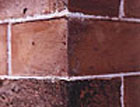Guide to bricklaying
Contrary to popular belief, bricklaying requires sophisticated skills. Good craftsmen use bespoke materials to repair old brickwork to traditional standards.


Although there are still highly accomplished bricklayers, brick expert and consultant Gerard Lynch laments a general decline in skill and status. Traditionally, the best bricklayers had a rounded education in the craft, incorporating the bricks themselves and the bonding patterns in which they could be laid, the lime mortar types that might be used and the sophisticated geometry needed for the construction of arches and other complex works. Now, although the Brick Development Association encourages a revival of imaginative brickwork, all too often, modern building is about 'fixing' pieces in place rather than 'crafting' the whole. David Watts of the National Trust's Calke Abbey-based works team and Mr Lynch both agree that those with a modern bricklayer's training are potentially capable of turning their hand to the higher forms of the craft,considering enthusiasm and dedication to be the key. The bricklayer's craft arguably reached its zenith in the late 17th to early 18th centuries, with the proliferation of complex gauged work. In this, precise joints and elaborate architectural forms were produced by rubbing low-fired bricks of soft, fine composition. Expensive gauged work was largely confined to arches, window and door reveals, and other special features, but in the 18th century especially, techniques were sometimes employed to imitate its effect where lower quality bricks were used. Tuck pointing achieved this by filling the joints with lime mortar colour to match the brick, so evening out its crudely formed edges. Brick Suppliers In past centuries, bricks were often fired on site. Specialist brickworks do remain today, though, such as Lambs in Sussex and the Bulmer Brick and Tile Company in Suffolk, which both manufacture hand-made bricks. Peter Minter of Bulmers has spent a lifetime in brick making. His firm's coal-fuelled down-draught kiln is currently fired about 25 times a year, producing about 12,000 bricks on each occasion. Bulmers now offer a bespoke service, producing bricks for many specific requirements. They strive to achieve the colour, density and feel of any brick required, and produce moulds for 'specials' used for details, which may have a production run of less than twelve. Bulmer bricks are currently in use at the Grade II listed orangery at Eltham. Contacts Brick Development Association Tel: 01344 885651 British Brick Society Web: www.britishbrick-soc.free-online.co.uk Society for the Protection of Ancient Buildings (Phone for details, suppliers and contractors) Tel: 020 7456 0916 Web: www.spab.org.uk
Sign up for the Country Life Newsletter
Exquisite houses, the beauty of Nature, and how to get the most from your life, straight to your inbox.
Country Life is unlike any other magazine: the only glossy weekly on the newsstand and the only magazine that has been guest-edited by HRH The King not once, but twice. It is a celebration of modern rural life and all its diverse joys and pleasures — that was first published in Queen Victoria's Diamond Jubilee year. Our eclectic mixture of witty and informative content — from the most up-to-date property news and commentary and a coveted glimpse inside some of the UK's best houses and gardens, to gardening, the arts and interior design, written by experts in their field — still cannot be found in print or online, anywhere else.
-
 'Monolithic, multi-layered and quite, quite magnificent. This was love at first bite': Tom Parker Bowles on his lifelong love affair with lasagne
'Monolithic, multi-layered and quite, quite magnificent. This was love at first bite': Tom Parker Bowles on his lifelong love affair with lasagneAn upwardly mobile spaghetti Bolognese, lasagne al forno, with oozing béchamel and layered meaty magnificence, is a bona fide comfort classic, declares Tom Parker Bowles.
By Tom Parker Bowles Published
-
 Country houses, cream teas and Baywatch: Country Life Quiz of the Day, April 24, 2025
Country houses, cream teas and Baywatch: Country Life Quiz of the Day, April 24, 2025Thursday's Quiz of the Day asks exactly how popular Baywatch became.
By Toby Keel Published
